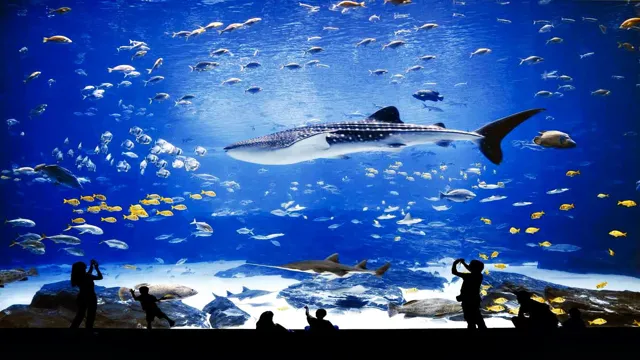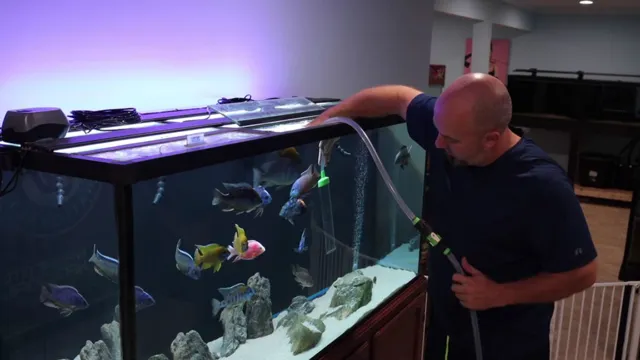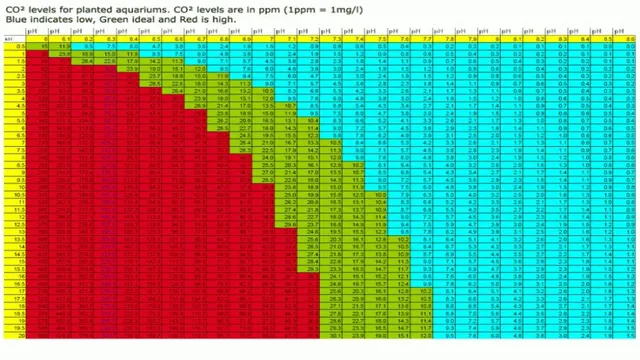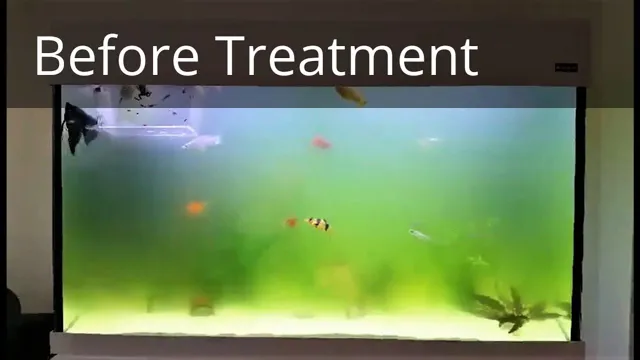When you think of a trip to an aquarium, the last thing on your mind might be how thick the glass is. But at the Georgia Aquarium, the glass thickness is an impressive feat of engineering that allows visitors to get up close and personal with some incredible aquatic creatures. The Georgia Aquarium is famous for its massive exhibits, which include everything from majestic whale sharks to playful otters.
But what sets it apart from other aquariums is the vast amount of space and variety of viewing options available to visitors. One of the most popular attractions is the Ocean Voyager exhibit, which is home to over 100 species of marine life and contains 3 million gallons of water.
This incredible exhibit is made possible by the use of enormous acrylic viewing windows that stretch 60 feet wide and 23 feet tall. But how thick is the glass used to create these windows? The answer might surprise you. The glass at the Georgia Aquarium is actually acrylic, not traditional glass, and is an incredible
5 feet thick. This thickness allows visitors to observe the marine life with minimal distortion and provides a safe environment for the creatures to thrive in. Next time you visit the Georgia Aquarium, take a moment to appreciate the engineering marvel that is the acrylic viewing windows.
These windows not only provide an amazing viewing experience but also demonstrate the incredible capabilities of modern materials science.
Introduction
Have you ever wondered how thick the glass is at the Georgia Aquarium? Well, let me tell you, it’s no ordinary glass. The acrylic panels that make up the aquarium’s exhibits are a whopping 2 to 4 feet thick! That’s more than double the thickness of a standard car windshield! The reason for this thickness is to withstand the immense pressure from the millions of gallons of water that fill the exhibits and to provide a safe environment for the creatures that call the aquarium home. In fact, one of the exhibits, Ocean Voyager, has the largest single-pane acrylic window in the world, measuring at 23 feet tall, 61 feet wide, and 2 feet thick.
So, next time you visit the Georgia Aquarium, take a closer look at the exhibits and appreciate the incredible engineering that goes into creating a beautiful and safe underwater world.
About the Georgia Aquarium
The Georgia Aquarium is a must-visit destination for anyone interested in marine life and breathtaking exhibits. The aquarium is located in Atlanta, Georgia, and features over 10 million gallons of water, which are home to thousands of animals from all around the world. From giant sea turtles to massive whale sharks, the Georgia Aquarium has it all.
Visitors can explore the aquarium’s many galleries and exhibitions and learn about the fascinating creatures that inhabit the ocean’s depths. One of the most popular exhibits is the Ocean Voyager, which is the world’s largest aquarium habitat and features a stunning array of marine life, including sharks, manta rays, and schools of colorful fish. If you’re visiting Atlanta, be sure not to miss this incredible attraction – the Georgia Aquarium truly is an aquatic wonderland!

Purpose of the Blog
The purpose of this blog is to provide readers with informative and engaging content on various topics related to technology, business, and digital marketing. Our goal is to help our readers stay up-to-date with the latest trends in these fields and gain new insights on how to improve their business and marketing strategies. We also aim to provide useful tips and tricks that can help our readers overcome challenges they may face in their professional lives.
Our content is geared towards professionals and business owners who are looking to improve their skills and knowledge in these areas. We hope that our blog will serve as a valuable resource for our readers and help them achieve their goals. So, buckle up and join us on this exciting journey of learning and growth! (See Also: How to Get Your Nitrate Levels Down in an Aquarium: Effective Tips and Tricks)
The Glass at Georgia Aquarium
If you’ve ever visited the Georgia Aquarium, you might have wondered just how thick the glass is that holds back all that water! And let me tell you, it’s pretty thick. In fact, the acrylic panels used at the Georgia Aquarium range from 2 to 4 inches in thickness, depending on the exhibit. The Ocean Voyager exhibit, which is home to the aquarium’s whale sharks, boasts some of the thickest glass in the world – up to 4 feet wide and 23 feet tall! But it’s not just the thickness of the glass that makes it so strong; the panels are designed to flex and distribute the weight of the water evenly, ensuring that they can withstand the force of millions of gallons of water without breaking.
So next time you visit the Georgia Aquarium, you can admire the underwater world without worrying about the glass giving way.
Types of Glass Used
At Georgia Aquarium, there are various types of glass used to provide the best possible aquatic experience to visitors. One of the most remarkable types of glass used is acrylic, also known as plexiglass, a material that is strong, clear, and lightweight. It’s used for the Ocean Voyager exhibit’s largest viewing window, which measures 63 feet wide by 26 feet tall and is over 2 feet thick.
The acrylic glass provides visitors with a seamless view, which is almost as if there’s no barrier between them and the marine life. Other exhibits use tempered glass, which is stronger than regular glass, less susceptible to thermal stress and shattering, and more durable. Georgia Aquarium ensures that the safety and well-being of both visitors and sea animals are top priorities, and they use only the highest quality materials to achieve this.
Thickness of Glass at Different Exhibits
When it comes to the exhibits at the Georgia Aquarium, the thickness of the glass varies depending on which exhibit you’re observing. For example, the Ocean Voyager exhibit, which is home to massive whale sharks and manta rays, features some of the thickest acrylic windows in the world at a staggering 23 inches thick. This is because the exhibit holds over
3 million gallons of water, making it one of the largest indoor aquatic environments in the world. On the other hand, some of the smaller exhibits, such as the Jellyfish exhibit, may only have windows that are a few inches thick. Despite the varying thickness of the glass, visitors can rest assured that each exhibit undergoes rigorous testing to ensure the safety and well-being of the marine animals.
So, if you’re looking to experience awe-inspiring underwater creatures up close, the Georgia Aquarium’s exhibits have got you covered.
Factors Affecting Glass Thickness
One of the most incredible things about the Georgia Aquarium is the massive tank holding over 6 million gallons of water. While this may seem impossible to contain without any leaks, the glass used in the construction of the tank is incredibly thick, measuring up to 18 inches in certain areas. Factors that affect glass thickness include the size and shape of the tank, the water pressure, and the type of marine life that will occupy the tank.
In the case of the Georgia Aquarium, engineers had to ensure that the glass was thick enough to withstand the pressure of millions of gallons of water, as well as the weight of whale sharks, manta rays, and other large marine creatures. The glass used had to be strong but also clear, so visitors can view the animals without any distortion. It’s fascinating to think about the engineering feats required to build such a massive aquarium, and the crucial role that glass thickness plays in ensuring the safety and well-being of the animals inside.
Safety Measures
If you’re curious about the safety measures at the Georgia Aquarium, one question that may come to mind is how thick the glass is in some of the exhibits. Well, it depends on the exhibit and the type of fish and animals within it. For example, the Ocean Voyager exhibit, which houses whale sharks, manta rays, and other large sea creatures, has a viewing window that is 26 inches thick and composed of acrylic material.
But the thickness of the glass isn’t the only safety measure in place at the Georgia Aquarium. The aquarium staff takes a comprehensive approach to ensuring the safety of the animals and guests. For example, each exhibit has its own team of trained professionals who monitor the animals’ health, behavior, and feeding habits. (See Also: How to Add Decorations to Aquarium: Tips and Ideas for Stunning Underwater Displays)
Additionally, the aquarium has a network of sensors and cameras that constantly monitor the water quality, temperature, and other environmental factors in the exhibits. Visitors can also play an active role in maintaining a safe and healthy environment. Guests are encouraged not to tap on the glass or disturb the animals and to follow all posted rules and guidelines.
By working together, the Georgia Aquarium is able to provide a safe and enjoyable experience for both its animal residents and human visitors.
Regulations and Certification
When it comes to regulations and certification, safety measures are a top priority. Whether it involves a product, service, or process, ensuring safety is crucial to avoid harm to customers and employees. An important step in achieving safety is obtaining certification from a recognized body.
Certifications like ISO 9001, ISO 45001, and OHSAS 18001 are globally recognized standards that provide assurance to stakeholders that an organization has implemented adequate safety measures. These certifications assess an organization’s approach to risk management, safety procedures, training and awareness, and emergency response plans. However, obtaining certification is not enough; maintaining compliance with safety regulations is an ongoing responsibility to retain certification and ensure safety.
Overall, safety measures are critical for any organization seeking to achieve excellence in their operations and maintain trust from stakeholders.
Maintenance and Inspection Protocols
When it comes to keeping your facility safe and secure, maintenance and inspection protocols are essential. Safety measures should always be a top priority, and this means taking the time to regularly check and maintain your equipment and infrastructure. Regular inspections of wiring, plumbing, and HVAC systems can go a long way in identifying potential hazards before they become major issues.
It’s also important to keep up-to-date records of all maintenance and inspections to ensure that nothing gets overlooked. When it comes to safety, there’s no room for shortcuts or cutting corners. By following proper maintenance and inspection protocols, you can help ensure the safety of your facility and everyone within it.
So take the time to invest in safety measures, and you’ll reap the rewards in the form of a secure and successful business.
Conclusion
In the end, the question of how thick the glass is at Georgia Aquarium is not just a matter of physical measurements. It’s a testament to the engineering ingenuity that makes experiences like walking through an underwater tunnel alongside sharks and whales possible. It’s also a reflection of the enduring human fascination with the mysteries of the deep and our ongoing quest to explore and understand the natural world.
So whether you’re a curious visitor or a seasoned marine biologist, next time you find yourself gazing at that shimmering wall of water, take a moment to appreciate the wonder and complexity that lies just beyond its surface – and maybe give that glass a respectful tap, just to be sure.” (See Also: How to Get to London Aquarium from Paddington: A Comprehensive Guide)
FAQs
What is the thickness of the glass at Georgia Aquarium?
The glass at Georgia Aquarium varies in thickness depending on the exhibit, but the thickest glass is approximately 2 feet thick.
How was the glass at Georgia Aquarium made?
The glass was custom-made using a process called lamination, where layers of glass are fused together with a strong resin.
Is the glass at Georgia Aquarium safe for the animals?
Yes, the glass at Georgia Aquarium is specially designed to withstand the pressure and weight of the water, ensuring the safety of the animals.
How much does the glass at Georgia Aquarium weigh?
The glass at Georgia Aquarium can weigh several tons, depending on its size and thickness.
How long did it take to install the glass at Georgia Aquarium?
The installation process for the glass at Georgia Aquarium took several months and involved a highly skilled team of engineers and technicians.
How often is the glass at Georgia Aquarium cleaned?
The glass at Georgia Aquarium is cleaned on a daily basis to ensure maximum visibility for visitors and a healthy environment for the animals.
Can visitors touch the glass at Georgia Aquarium?
No, visitors are not allowed to touch the glass at Georgia Aquarium as it is carefully maintained to ensure the safety and health of the animals.






